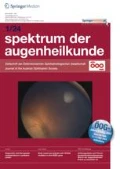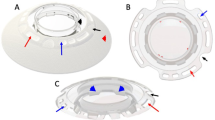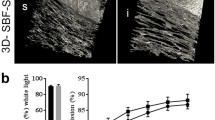Summary
Background
The MIRO® CORNEA UR is a new keratoprosthesis made of a single piece of flexible, hydrophobic acrylic polymer. The geometry is based on the original Cardona design, allowing epicorneal as well as intrastromal implantation. The haptic is coated with genetically engineered fibronectin, supporting the adherence of surrounding tissue. The flexibility of the haptic minimizes shear stress between keratoprosthesis and ocular tissue, and supports intraocular pressure monitoring in patients with a high incidence of glaucoma.
Material and methods
The MIRO® CORNEA UR was implanted into one eye each of four corneally blind patients suffering from autoimmune disease or severe burns. The haptic was implanted in a pocket between the ocular globe and beforehand transplanted autologous buccal mucosa, and additionally secured by a skirt of donor sclera or a collagen membrane.
Results
In three out of four eyes, the surrounding tissue firmly adhered to the haptic and penetrated the holes in the haptic. Throughout the follow-up period of 20–52 months, the haptics were firmly integrated into the surrounding tissue without signs of inflammation. Postoperative medication included antibiotics and cortisone drops. The eyes remained stable, well pressurized and free from infection. Neither tissue melting nor ingrowth of epithelial cells along the tissue–keratoprosthesis interface were observed.
Conclusions
The MIRO® CORNEA UR keratoprosthesis may be an alternative to the osteo-odonto-keratoprosthesis (OOKP) in the treatment of corneally blind patients with autoimmune disease or severe burns. In the future, indications may include deep corneal vascularization for example after ocular infection.
Zusammenfassung
Grundlagen
Die MIRO® CORNEA UR Keratoprothese wird aus einem einzigen Stück flexiblen, hydrophoben Acrylatpolymers gefertigt. Die Geometrie lehnt sich an das ursprüngliche Cardona-Design an, das sowohl die epicorneale als auch die intrastromale Implantation erlaubt. Die Beschichtung der Haptik mit gentechnisch hergestelltem Fibronektin unterstützt das Einwachsen in das umgebende Gewebe. Die Flexibilität der Haptik minimiert die Scherkräfte zwischen der Keratoprothese und dem Augengewebe und erleichtert die Überwachung des intraokularen Drucks in einem Patientengut mit häufig auftretendem Glaukom.
Material und Methodik
Die MIRO® CORNEA UR wurde in jeweils ein Auge von vier hornhautblinden Patienten mit Autoimmunerkrankung oder schweren Verbrennungen und Verätzungen implantiert. Die Haptik wurde in eine Tasche zwischen Auge und zuvor transplantierter autologer Mundschleimhaut positioniert und mit einer Manschette aus Spendersclera oder einer Kollagenmembran zusätzlich gesichert.
Resultate
In drei der vier Augen verwuchs das umgebende Gewebe fest mit der Haptik und durchdrang deren Löcher. Während der gesamten Nachbeobachtungszeit von 20 bis 52 Monaten waren die Haptiken fest in das umgebende Gewebe integriert ohne Anzeichen einer Entzündung. Postoperativ wurden die Augen mit Antibiotika und Cortison Augentropfen behandelt. Sie blieben stabil, mit gutem Tonus und frei von Infektionen. Weder Einschmelzen von Gewebe, noch Einwachsen von Epithelzellen an der Grenze zwischen Keratoprothese und umgebendem Gewebe wurden beobachtet.
Schlussfolgerungen
Die MIRO® CORNEA UR Keratoprothese könnte eine Alternative sein zur Osteo-Odonto-Keratoprothese (OOKP) zur Behandlung hornhautblinder Patienten mit Autoimmunerkrankung oder schweren Verbrennungen oder Verätzungen. In der Zukunft könnten die Indikationen tiefe Hornhautvaskularisationen einschließen, wie sie nach schweren Augeninfektionen auftreten.











Similar content being viewed by others
References
WHO. Global data on visual impairments 2010. Geneva: World Health Organization; 2012.
Zirm E. Eine erfolgreiche totale Keratoplastik. Albrecht v Graefes Arch Ophthalmol. 1906;64:580–93.
Zirm EK. Eine erfolgreiche totale Keratoplastik (a successful total keratoplasty). 1906. Refract Corneal Surg. 1989;5(4):258–61.
Liekfeld A. Keratoplastik: Indikationen und Techniken. Concept Ophthalmol. 2010;3:36–7.
Cursiefen C. Hornhauttransplantation: Glänzende Bilanz und viele Perspektiven. Dtsch Ärztebl. 2005;102(45):A3078–80.
Hille K, Landau H, Ruprecht KW. [Osteo-odonto-keratoprosthesis. A summary of 6 years surgical experience]. Ophthalmologe. 2002;99(2):90–5.
Heiligenhaus A, et al. Empfehlungen zur Diagnostik und Therapie beim Schleimhautpemphigoid am Auge. Berlin: Arbeitsgruppe Immunologie und Infektiologie der Sektion Kornea der Deutschen Ophthaklmologischen Gesellschaft DOG; http://www.dog.org/?cat=121#8 (2005).
Schöpf E, et al. Toxic epidermal necrolysis and Stevens-Johnson syndrome. An epidemiologic study from West Germany. Arch Dermatol. 1991;127(6):839–42.
Mockenhaupt M, et al. Epidemiology of staphylococcal scalded skin syndrome in Germany. J Invest Dermatol. 2005;124(4):700–3.
Lund OE. [Use of synthetic implants in the cornea and conjunctiva. Keratoprosthesis]. Ber Zusammenkunft Dtsch Ophthalmol Ges. 1978;75:173–80.
Lund OE. [Limits and possibilities of optical keratoprosthesis. A clinical and histopathological report (author’s transl)]. Klin Monatsbl Augenheilkd. 1982;180(1):3–12.
Sommer G. Keratoprothetik (Teil 1). Folia Ophthal. 1984;9:-129–37 (Leipzig).
Sommer G. Keratoprothetik (Teil 2). Folia Ophthal. 1984;9:-189–202 (Leipzig).
Sommer G. Keratoprothetik (Teil 3). Folia Ophthal. 1984;-9:285–91 (Leipzig).
Hille K. [Keratoprostheses. Historical overview, materials and status of current research]. Ophthalmologe. 2002;99(7):513–22.
Gomaa A, Comyn O, Liu C. Keratoprostheses in clinical practice—a review. Clin Exp Ophthalmol. 2010;38(2):211–24.
Cardona H. Keratoprosthesis with a plastic fiber meshwork supporting plate. Report of an experimental and comparative histologic study. Am J Ophthalmol. 1967;64(2):228–33.
Cardona H. Keratoprosthesis; acrylic optical cylinder with supporting intralamellar plate. Am J Ophthalmol. 1962;54 :284–94.
Cardona H. Anterior and posterior mushroom keratoprostheses. An experimental study. Am J Ophthalmol. 1966;61(3):498–504.
Cardona H. Mushroom transcorneal keratoprosthesis (bolt and nut). Am J Ophthalmol. 1969;68(4):604–12.
Dohlman CH, et al. Collar-button prosthesis glued to a corneal graft. In: Polack FM, editor. Cornea and external diseases of the eye. First Inter-American Symposium. Springfield: Charles C. Thomas; 1970. pp. 189–92.
Strampelli B. [Osteo-odonto-keratoprosthesis]. Ann Ottalmol Clin Ocul. 1963;89:1039–44.
Girard LJ, et al. Prosthetosclerokeratoplasty-implantation of a keratoprosthesis using full-thickness onlay sclera and sliding conjunctival flap. Trans Am Acad Ophthalmol Otolaryngol. 1969;73(5):936–61.
Deutschmann S. Probleme um die Entwicklung von Keratoprothesen. Augenoptik. 1978;95:8–11.
Jähne MG. [25 years Cardona keratoprosthesis after severe chemical eye burns–long-term outcome of 4 eyes]. Klin Monbl Augenheilkd. 2000;216(4):191–6.
Falcinelli GC, et al. Osteo Odonto Keratoprosthesis Up to Date. Acta XXV Concilium Ophthalmologicum: proceedings of the XXVth International Congress of Ophthalmology; 4–10 May 1986; Rome, Italy. Amsterdam: Kugler and Ghedini; 1987. p. 2772–6.
Falcinelli GC, et al. Osteoodontokeratoprosthesis: present experience and future prospects. Refract Corneal Surg. 1993;9:193.
Hille K, et al. Standards for modified osteoodontokeratoprosthesis (OOKP) surgery according to Strampelli and Falcinelli: the Rome-Vienna Protocol. Cornea. 2005;24(8):895–908.
Zerbe BL, Belin MW, Ciolino JB. Results from the multicenter Boston Type 1 Keratoprosthesis Study. Ophthalmology. 2006;113(10):1779.e1–7.
Storsberg J, et al. Künstliche Augenhornhaut: Biomaterialentwicklung eines ophthalmologischen Implantats mit biomimetischen Funktionalitäten. DZKF Dtsch Z Klinische Forsch. 2011;5/6:58–61.
Kobuch KA, et al. Towards an artificial cornea: evaluation of a new designed hydrophobic one-material implant with modified surfaces in vitro and in vivo. ARVO Meeting Abstracts. 2008;49:5706.
D.o.O.D. Intraocular and Corneal Implants Branch, Office of Device Evaluation, editor. Guidance on 510(k) Submissions for Keratoprostheses. Rockville: Center for Devices and Radiological Health CDRH, US Food and Drug Administration FDA; 1999.
Kobuch K, et al. The MIRO® KPro—a new designed one-material implant with modified surfaces: histological evaluation of biointegration and stability in vitro, in vivo and after first clinical applications. Abstract Book, KPro Study Group, 9th KPro Meeting, April 12, 2014. Salzburg.
Schrage N, Hille K, Cursiefen C. Aktuelle Versorgungsmöglichkeiten mit Keratoprothesen: Boston KPro, Osteoodontokeratoprothese (OOKP), Miro Cornea und KeraClear. Der Ophthalmologe. 2014;111(11):1010–18.
Acknowledgments
The authors wish to express their sincere thanks to Siegfried Deutschmann for sharing his experience from manufacturing more than 100 Cardona type keratoprostheses for Gerd Sommer between 1969 and 1988, to Manfred Jähne for contributing his medical experience gained during his work with Gerd Sommer in Zittau from 1967 to 1978, to Karin Kobuch for her valuable contribution in the development of the MIRO® CORNEA UR, and to Saadettin Sel for the implantation of keratoprosthesis prototypes into rabbit eyes.
This work was supported by the European Commission under the 6th framework program FP 6, project acronym cornea, grant no. COOP-CT-2005-017905.
Conflict of interest
Wolfgang G. K. Müller-Lierheim is the President and CEO of MIRO® GmbH, Kaflerstr. 15, 81241 München, Germany, the manufacturer of the MIRO® CORNEA UR keratoprosthesis.
The authors declare that there are no actual or potential conflicts of interest in relation to this article.
Author information
Authors and Affiliations
Corresponding author
Rights and permissions
About this article
Cite this article
Duncker, G., Storsberg, J. & Müller-Lierheim, W. The fully synthetic, bio-coated MIRO® CORNEA UR keratoprosthesis: development, preclinical testing, and first clinical results. Spektrum Augenheilkd. 28, 250–260 (2014). https://doi.org/10.1007/s00717-014-0243-4
Received:
Accepted:
Published:
Issue Date:
DOI: https://doi.org/10.1007/s00717-014-0243-4




